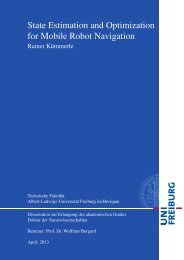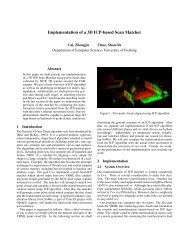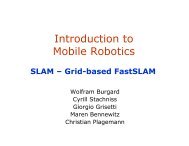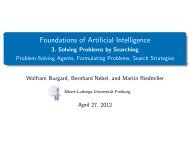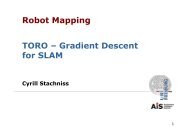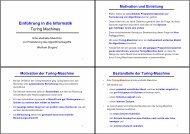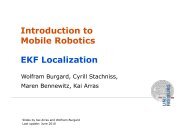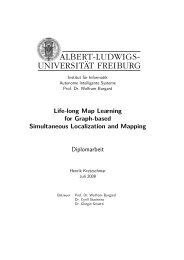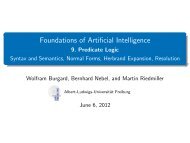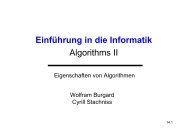Improved Monte Carlo Localization of Autonomous Robots through ...
Improved Monte Carlo Localization of Autonomous Robots through ...
Improved Monte Carlo Localization of Autonomous Robots through ...
You also want an ePaper? Increase the reach of your titles
YUMPU automatically turns print PDFs into web optimized ePapers that Google loves.
translational error [m]<br />
rotational error [degree]<br />
success rate<br />
1<br />
0.8<br />
0.6<br />
0.4<br />
30<br />
25<br />
20<br />
15<br />
10<br />
1<br />
0.8<br />
0.6<br />
0.4<br />
0.2<br />
0<br />
extended<br />
standard<br />
extended<br />
standard<br />
extended<br />
standard<br />
0 2000 4000 6000 8000 10000<br />
number <strong>of</strong> particles<br />
Fig. 3. The average RMS localization error and the success rate <strong>of</strong> the<br />
extended <strong>Monte</strong> <strong>Carlo</strong> localization with simultaneous parameter estimation<br />
compared to the standard localization with previously learned parameters <strong>of</strong><br />
the motion model. The error bars indicate the 5% confidence intervals over<br />
ten runs.<br />
together and a third laterally mounted rear propeller for yaw<br />
rotation. Four small, lightweight wide-angle sonar sensors<br />
provide distance measurements to the environment, which<br />
are probabilistically modeled as described in our previous<br />
work [15]. The experimental indoor environment has an area<br />
for flying <strong>of</strong> about 14×7 m 2 with a vertical space <strong>of</strong> 5 m and<br />
was mapped from 3D laser scans using multi-level surface<br />
maps [24]. To determine the localization error, we put visual<br />
markers onto the floor, which allow us to accurately calculate<br />
the pose <strong>of</strong> the vehicle using the camera integrated in the<br />
gondola <strong>of</strong> the blimp [1].<br />
In an extensive experiment <strong>of</strong> about 9 minutes <strong>of</strong> manually<br />
operated flight the blimp covered a distance <strong>of</strong> about 180 m.<br />
Since we did not use an IMU and the wide-angle sonar<br />
sensors provide hardly any information about the orientation<br />
<strong>of</strong> the blimp, the localization relies on an accurate prediction<br />
<strong>of</strong> the motion model. As can be seen in Fig. 3, the <strong>Monte</strong><br />
<strong>Carlo</strong> localization with simultaneous estimation <strong>of</strong> initially<br />
unknown parameters benefits from the improved proposal<br />
distribution. It resulted in a significantly lower rotational<br />
localization error compared to the results obtained using the<br />
implementation with previously learned (see section IV) and<br />
fixed parameters <strong>of</strong> the motion model. The estimate <strong>of</strong> the<br />
parameter vector typically converged within the first minute<br />
<strong>of</strong> the experiment. Although the dimensionality <strong>of</strong> the state<br />
estimation problem was increased by the four parameters, the<br />
localization success rate revealed that the number <strong>of</strong> particles<br />
required to reliably localize the blimp is substantially smaller<br />
using the simultaneous parameter estimation.<br />
Furthermore, we tested our localization system with simultaneous<br />
parameter estimation in a global localization<br />
szenario with initially unknown pose and motion model<br />
parameters. We carried out 10 runs with 5,000 particles<br />
each. Whereas the pose estimate typically converged within<br />
the first 10 seconds, it still took 1 minute to determine<br />
the parameters. Based on these experiments we expect that<br />
translational error [m]<br />
rotational error [deg]<br />
0.1<br />
0.09<br />
0.08<br />
0.07<br />
0.06<br />
0.05<br />
5<br />
4.5<br />
4<br />
3.5<br />
3<br />
2.5<br />
2<br />
0 0.05 0.1 0.15 0.2 0.25 0.3<br />
relative covariance bound<br />
Fig. 4. The average translational and rotational RMS localization error<br />
<strong>of</strong> a 10 minute localization experiment on simulation data. The error bars<br />
indicate the 5% confidence intervals over ten runs.<br />
our approach can also handle the kidnapped robot problem<br />
given an extension which can distinguish between parameter<br />
changes and kidnappings based on drops <strong>of</strong> the observation<br />
likelihood.<br />
B. Simulation <strong>of</strong> Changing Parameters<br />
To evaluate the capability <strong>of</strong> our localization system to<br />
adapt to changing parameters <strong>of</strong> the motion model, we<br />
performed a series <strong>of</strong> experiments on a simulated blimp<br />
using our deterministic motion model. The true poses were<br />
passed as observations to the localization system and their<br />
likelihood were modeled as a Gaussian distribution with high<br />
translational and low rotational precision (σ trans = 0.2 m,<br />
σ rot = 15 ◦ ).<br />
In an experiment <strong>of</strong> about 10 minutes <strong>of</strong> manually operated<br />
flight we evaluated different relative covariance bounds ρ in<br />
our localization system using 5,000 particles. Note that we<br />
experimentally tuned the parameters α short = 0.2, α long =<br />
0.01, and ν = 0.8 to obtain best results. Although we<br />
introduced only little noise to the velocity <strong>of</strong> the blimp during<br />
simulation, the parameter estimation during localization was<br />
a challenging task due to the correlation <strong>of</strong> the different<br />
parameters (see Fig. 5). Furthermore, estimating all parameters<br />
requires a certain spectrum <strong>of</strong> movements. For example,<br />
during the first seconds <strong>of</strong> our experiment the blimp was<br />
controlled to move forward only which resulted in a quick<br />
convergence <strong>of</strong> solely the drag coefficient D x .<br />
Fig. 4 presents the localization accuracy on the simulated<br />
data during which the parameters <strong>of</strong> the motion model were<br />
changed as depicted in Fig. 5. Both, the translational and<br />
rotational localization error are significantly lower for a<br />
relative covariance bound <strong>of</strong> ρ > 0.15 than without a lower<br />
bound (ρ = 0) <strong>of</strong> the covariance <strong>of</strong> the parameters.<br />
VI. CONCLUSIONS<br />
In this paper, we presented a novel approach to <strong>Monte</strong><br />
<strong>Carlo</strong> localization <strong>of</strong> autonomous robots with simultaneous<br />
estimation <strong>of</strong> the parameters <strong>of</strong> the motion model. In<br />
contrast to other approaches, our systems allows an online<br />
localization without prior knowledge <strong>of</strong> all motion model<br />
parameters and can adapt to changed parameters during<br />
operation. To avoid oscillations after parameter changes on<br />
systems, for which these changes can only be detected with a



